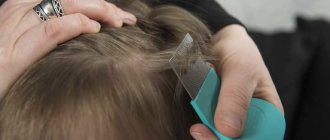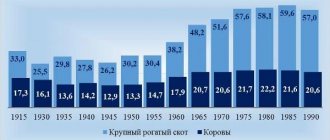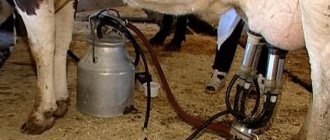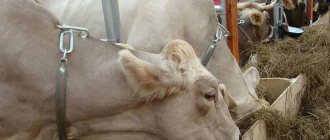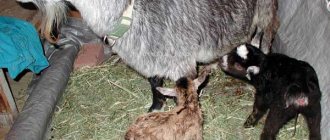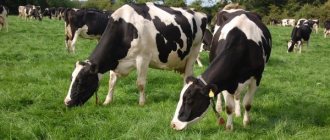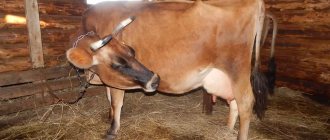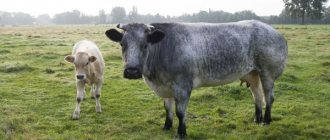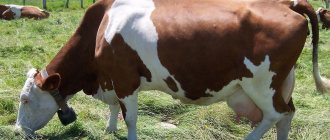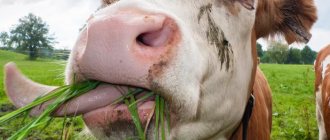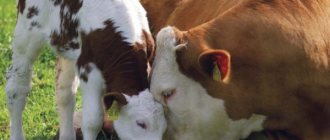If you decide to have a cow, you should first find out when the cow gives milk. After all, this good-natured animal is a real nurse. It produces a tasty and healthy product that can be used for your own nutrition or profitably sold in its natural form. Secondary products also have excellent characteristics. It is enough to carry out a simple processing and now we have sour cream, cottage cheese, cheese, butter, yogurt or something else that is no less tasty and healthy. However, the production process does not last forever.
When do cows start producing milk?
Cows do not produce milk until their first calves are born. This happens when the cow reaches the age of one and a half or even two years. Milk appears at the very end of a cow's pregnancy or after the birth of her first calf. The very first milk is intended for born calves. It has a high level of fat content and thickness.
Important! When the calf is weaned from the mother (feeding stops), lactation does not stop, but only if you start milking the cow on time. The animal will continue to produce milk until its final pregnancy.
Lactation period
The lactation period has three phases:
Colostrum
This is the initial stage after calving and can last from 7 to 10 days. Colostrum contains a lot of nutrients, such as protein, fats, various vitamins, microelements and other nutrients.
It also contains a high concentration of lactobacilli and other additional microorganisms useful for the functioning of digestion.
This is the very first food for the calf, thanks to which it develops immunity to its environment and the opportunity to create additional positive bacteria for the digestive system.
Causes of milk production in cows
The appearance of milk occurs due to the process of lactation, which is a natural consequence. In this case, milk depends on various factors:
- Health . The cow must receive all the necessary vitamins and nutritional supplements on time. It is for this reason that it is necessary to regularly examine the animal by a veterinarian.
- Breed . Depending on selection, there are breeds that produce a lot of milk of varying fat content.
- Correct milk yield . After the birth of newborn calves, the number of milkings should be gradually reduced.
- Age . The younger the cow, the less milk she produces. Large milk yields appear only after the fifth birth.
- Time of birth of the calf . If a cow gives birth in winter, she can produce more milk than in summer. Moreover, if a cow is milked, the milk yield will be stable.
How many days does it last?
The normal duration of lactation in cows occurs within 305 days. But this is not a constant indicator, since everything depends on the fertilization of the female.
Ideally, calving occurs at the same time after conception, which is approximately 1 year. In this case, lactation can last up to approximately 315 days, and the dry period can last up to 60 days.
This stage is very individual, it all depends on the breed, position of the cow, and, most importantly, on maintenance and nutrition.
The secretion of milk fluid is a reflex, since in principle it cannot be caused artificially, everything is natural. Milk arrives at the time of delivery or before the day the baby is due to calve, but this happens very rarely.
The mammary gland changes when the cow is still pregnant, that is, the adipose tissue of the udder is replaced by secretory alveoli, and after a certain time has passed, the udder begins to grow.
The milk begins to decrease, the cow is not milked until the next birth. The mammary glands are in a period of rest, during this time the recovery process occurs, and then everything starts from the very beginning.
Hormones take over the main development of the udder, this is all visible during the first pregnancy. There are individuals in whom the mammary glands can account for 3% of the total fat mass; the heart and its system are subject to a large load.
Drugs should be added to the diet to increase milk production.
Average milk yield
The most favorable age of cows for milking is from 4 to 7 years. Over time, the amount of milk the animal produces decreases significantly. The fact is that the animal’s body begins to recover much longer and the effectiveness of the vitamins begins to decrease.
In addition, breed is important. Breeders were able to create special breeds that are highly productive in milk yield. Pedigree cows can produce about 5 thousand liters of milk per year.
Indicators of average monthly milk yield
Unfortunately, the exact amount of milk a cow produces in one month cannot be calculated. The indicator depends on a number of factors:
- climate zone;
- cow nutrition;
- breeds
Israeli farmers receive the most milk yield, whose cows produce more than 1,500 liters per month. At the same time, European farming enterprises are capable of producing up to 700 liters per cow. On domestic farms, a cow can produce up to 400 liters/month.
Low milk and dairy free
Horse milk
In veterinary medicine, the phenomenon of low milk production is called hypogalactia, and milklessness is called agalactia. Diseases arise and develop as a result of various influences on the cow’s body and age-related changes within the body. As a rule, they can occur not only when the cow produces milk, but much earlier.
Common types of diseases are:
- stern;
- artificial;
- climatic;
- operational;
- physiological;
- deposition.
When fodder agalactia occurs, an insufficient amount of certain life-giving substances (vitamins, proteins, minerals) is observed in the cow’s body. The solution will be balanced feeding and a strict food supply schedule.
Artificial agalactia is caused by incorrect actions of the owner. Sharp changes in the care of the cow, attitude towards her, change in diet. Therefore, everything needs to be done gradually: switch from one type of food to another, change the staff and environment, and not traumatize the psyche of the ward.
Sudden changes in the cow's care, attitude towards her, or changes in diet can affect milk production
The next type of disease - climatic - is associated with changes in weather, temperature, and living conditions. The room where the cattle is located can be changed: it should be clean, ventilated, but without drafts. Pastures are a little more complicated. Here you can only monitor the weather, reducing grazing in hot weather or increasing the walking time on favorable days.
Note! Everything related to improper care of the cow leads to the occurrence of diseases. Untimely preparation for the milking period, incorrectly determined age for fertilization, lack of breaks in milking before calving are the reasons for little or no milk production.
Agalactia, caused by physiological factors, is accompanied by the occurrence of various diseases. Moreover, these can be not only diseases of the udder (mastitis, cracked nipples, swelling), but also ordinary stomach disorders, pests, general weakening of the body, which can lead to loss of milk.
Movement plays an important role in good milk yield. Therefore, the cow needs frequent walks in the fresh air. Approximately 2-3 hours a day outside the pen is enough for her to have good quality milk.
Important! In practice, low milk yields are rarely caused by one of the problems described above; as a rule, the amount of milk is influenced by several factors at once.
You should pay attention to whether the volume of milk gradually or suddenly decreases, how old the cow is, what month of pregnancy she is and how long she has been milking.
How long can one cow produce milk?
Animals are capable of producing milk most of their lives and at any time of the year. Lactation periods can be divided into certain phases:
- Growing up. The process begins from the moment the cow is born and lasts up to 2 years. After this, the cow gives birth to calves and begins to produce milk.
- Maturity. The period can last for most of the cow's life - up to 15 years.
- Withering. After reaching the age of approximately fifteen years, the animal stops producing milk.
Useful tips from "Southern Crown"
Among them:
- When choosing the same type of feeding for dairy cows at any time of the year, it is important to create stable conditions and not change the diet. Clover, corn and other crops need to be sown in large areas. It is recommended to graze cows on pasture in the summer only until lunchtime.
- To increase the nutritional value of the diet, use various feed additives. They will not only help increase the quantity and quality of milk, but also strengthen the immune system and improve the general condition of the animals.
- To increase productivity, it is necessary not only to select individual feeds, but also to increase the concentration of metabolic energy in dry matter during feeding and optimize its ratio with protein.
- Combine pelleted natural mixtures with silage and other bulky feeds. This will eliminate improper functioning of the rumen, a reduction in milk volumes and a decrease in its fat content.
Organize standardized feeding of dairy cattle, taking into account the needs of the phases of lactation. This can activate the genetic potential of cows' milk production accumulated over the years.
How to treat mastitis at home
There are mild forms of mastitis that do not require serious intervention and can be easily treated at home. To do this, you need to thoroughly wash the udder with warm water with added salt. Salt can be replaced with a light decoction of nettles.
If seals are present, then after the milking is completed, they need to be massaged. Movements should be smooth, from top to bottom. If there are purulent deposits, massage will help remove them through the nipples.
Fibrous mastitis, as well as catarrhal mastitis, can be treated with clay application. This method has been used for a very long time, and judging by the reviews it is very good. Clay is used white or red. Next, herbs are brewed (plantain, nettle, yarrow). The clay is diluted with a decoction and applied to the udder. In the morning, the “mask” is washed off with a warm decoction of herbs (nettle, chamomile). This procedure will relieve swelling and pain. Almost all of them can be found at your summer cottage; they are antibacterial. In this case, massage is not used.
If hemorrhagic mastitis is detected in a cow, then constant milking should be carried out. This will remove blood clots. Massage can be applied when the inflammation subsides (use camphor ointment). The cow is also given boric acid, bear's ear leaves, the laxative Carlsbad salt and methenamine.
Treatment with traditional methods may include applications and heating. Vinegar can be added to application clay.
After 4 days of treatment, warming can be performed. They are done using a paraffin compress.
Milking process
The cow gets used to people very much, so it is advisable to be touched by familiar hands. Otherwise, the wayward animal will not want to be milked. It does not tolerate cruelty or rough treatment. With the right attitude towards the udder and nipples, she is able to produce a lot of milk.
Igor Nikolaev
auto RU
The process itself, how a cow gives milk, consists of the following actions:
- the pen is freed from dirt and manure, which creates a favorable environment for the proliferation of microbes and the occurrence of infection;
- a cow's tail can be tied to her leg, as she likes to swing it vigorously, especially when blood-sucking insects appear;
- With clean hands, wash the udder with warm water before milking, then blot it;
- Milk the first few small streams of milk into a separate container. It may contain particles of dust, pus or other foreign impurities;
- You can effectively get cow's milk only by regular and frequent squeezing of the nipples. The first milk does not require effort to come out. But after ten seconds the process becomes more complicated. You need to squeeze the nipples hard enough to reach the necessary receptors, which are located deep;
- The most effective effect will be on the base of the nipples. The compression frequency is one hundred times per minute. This frequency gives the best results. It takes a while to get used to it, but the result is worth it;
- periodically massage the udder to stimulate the flow of milk down to the alveoli. With both hands, take the right half of the udder and stroke it from bottom to top, then vice versa. Then they move on to the second half and do the same. This is followed by a nipple massage with light compressions without producing milk. The movements should imitate that of a baby cow when sucking. The entire procedure takes no more than thirty seconds.
The hormone oxytocin has a special secret in the process of obtaining milk. This is a release hormone that will appear by the third minute from the start of milking. Literally after five minutes it calms down. Therefore, you need to milk quickly in order to catch the period of action of oxytocin. Cows produce milk for a total of six minutes at a time;
- When the cows have given the main amount of the product, you need to repeat the massage according to the above scheme. Squeezing both hands, knead the udder, moving from top to bottom to the nipples four times and push out the remaining milk. The latter is considered the fattest - the balls show up to ten percent fat content.
More on the topic: How is it profitable to keep cows for milk?
Inflammation of the lungs (pneumonia)
Young individuals are most often affected. The main cause of the disease is a cold. Aggravates the condition:
- finding the animal in an insufficiently comfortable cold room;
- lack of ventilation;
- poor quality litter;
- lack of vitamin A in feed;
- deprivation of walks.
The first and main sign of pneumonia is a cough. It is accompanied by difficulty breathing. The animal is in a depressed state and has a runny nose. Temperature increased by 2 degrees.
Prevention:
- providing the animal with constant walks all year round;
- in winter, keeping in warm rooms is mandatory;
- changing the bedding to dry (hay, straw).
This is how you can avoid getting this disease. In critical cases, contacting a veterinarian is mandatory.
Types of milking machines
Machines are classified according to the types of engines installed. They are divided into equipment with a dry engine and an oil engine. The difference is that the blades of a dry motor are made of graphite material, which very quickly becomes unusable, and when it works, it creates a lot of noise. Therefore the price value is very low.
The oil-powered device has blades made of metal material, which move due to special lubricant. There is almost no noise. Durable to use.
The milking machine is classified according to the principle of "smart action" and the characteristics of the working process.
- According to the types of glasses installed, which can include both single- and double-chamber glasses.
- According to the method of milking, use two-act or three-act machines.
- By type of pumps - piston and centrifugal. A pump with pistons can operate without a connected pulsator. It is characterized by its low price and ease of use. A pump based on pulsators works better and produces high-quality milking.
- Milk collection. A household model with a convenient container that can be removed and easily drains the milk. Thanks to advanced production, there are special tubes that can be easily connected to the tank itself.
Behavior
Cow
is a herd animal. Each herd has its own dominant hierarchy, which is formed during clashes between individuals. Once established, it remains unchanged in a given herd. In general, the herd lives amicably and obeys its leader. Domestic cows use special odors and pheromones to communicate with each other. With the help of a developed sense of smell, they distinguish between the emotions of their relatives, especially fear and excitement. Head position is another means of communication. It expresses the animal’s mood (submissive, anxious). The mooing or roaring of cows serves to express suffering (with late milking), hunger, thirst, or the call of a calf or relative.
Cows spend about a third of the day grazing, another third chewing cud, and the rest of the time they rest.
Possible problems
Sometimes after calving, a cow may experience some difficulties. Therefore, you need to be especially attentive to the animal after birth.
It is very important that after calving the placenta comes out, otherwise it can lead to suppuration. Because of this, the animal may even die later.
If a calving cow does not stand up at all, this means only one thing - she has paresis. This is very dangerous as it can lead to paralysis of the animal. In this case, it is necessary to use special medications that will help cope with the disease.
It happens that a cow can carry a calf. In this case, you need to wait 5-6 days, and then move on to more drastic actions. It is necessary to administer special drugs to her that will artificially induce labor. To do this, you can use Oxytocin or other drugs with the same effect. After this, the calf is born more weakened. Therefore, he will need some massage to restore muscle tone. However, they then develop normally.
After calving, another problem such as hypocalcemia may also arise. The cow eats very poorly, becomes lethargic, and in addition, during milking, milk does not flow very actively. This is due to the fact that not only the level of calcium, but also phosphorus in the cow’s blood decreases. This occurs as a result of improper feeding of the animal before birth. As a result, the cow may become obese. To combat the disease, specially prepared cocktails containing vitamins can be administered intramuscularly. However, it is best to take care of proper feeding of the cow before giving birth.
Sometimes you can see blood clots appear in the milk. This indicates that the cow is undergoing an inflammatory process. Most often this is mastitis, which can be caused by improper milking or improper starting. To avoid this, you need to milk your cow at least 5 times a day after giving birth. In addition, be sure to massage the udder before each milking.
As a result of too difficult a birth, the animal may even experience internal bleeding. In this case, you need to give an injection using the drug “Oxytocin”. With its help, the uterus will contract, which will stop the bleeding. This also significantly activates lactation. If internal organs are damaged, the cow may need surgery.
See below for the cow's calving features.
Methods for ensuring milk productivity
In order to successfully engage in dairy farming, you need to implement several important steps:
- choose a healthy cow with strong immunity of the optimal dairy breed;
- create conditions for keeping the animal - prepare a heating system, feeders and drinking bowls, hygiene and cleaning products;
- purchase feed of the required quality and in the required quantity;
- prepare a pasture or place where the cow will graze;
- choose the optimal milking method - manually or using a machine;
- in order to maintain the health of the animal, it is necessary to give it vaccinations in a timely manner, maintain hygiene, and treat the skin against parasites and bloodsuckers;
- carry out anthelmintic prophylaxis every 6-8 months, conduct blood and milk tests annually.
By following these measures, it is possible to create the best conditions for keeping cattle, which is realized in high yields of high-quality and tasty milk.
The production of a dairy product is a very complex process, and therefore farmers have developed many useful solutions and secrets that help increase productivity. Knowledge of the rules for keeping, feeding, and milking an animal is an integral factor in achieving the required milk parameters.
